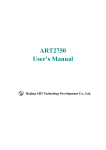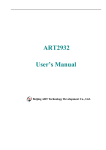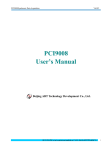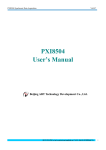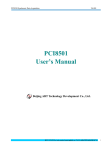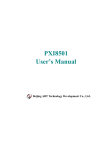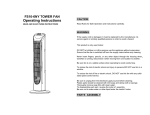Download PCI8100 User`s Manual
Transcript
PCI8100 User’s Manual Beijing ART Technology Development Co., Ltd. PCI8100 Data Acquisition Contents Contents ................................................................................................................................................................................2 Chapter 1 Overview ..............................................................................................................................................................3 Chapter 2 Components Layout Diagram and a Brief Description .......................................................................................5 2.1 The Main Component Layout Diagram ..................................................................................................................5 2.2 The Function Description for the Main Component ...............................................................................................5 2.2.1 Signal Input and Output Connectors ............................................................................................................5 2.2.2 Jumper..........................................................................................................................................................6 2.2.3 Potentiometer ...............................................................................................................................................6 2.2.4 Physical ID of DIP Switch ...........................................................................................................................6 2.2.5 Status Indicator.............................................................................................................................................7 Chapter 3 Signal Connectors................................................................................................................................................8 Chapter4 Connection Ways for Each Signal.........................................................................................................................9 4.1 Analog Output Signal Connection ..........................................................................................................................9 4.2 External Clock Signal Input Connection.................................................................................................................9 4.3 Clock Signal Output Connection ............................................................................................................................9 4.4 External Trigger Signal Connection (DTR) ............................................................................................................9 4.5 External Trigger Signal Connection (ATR)...........................................................................................................10 4.6 Digital Input/Output Connection Mode ................................................................................................................10 Chapter 5 The Instruction of Trigger and Clock Functions ................................................................................................11 5.1 Trigger Mode ........................................................................................................................................................11 5.1.1 Single Trigger Mode ..................................................................................................................................11 5.1.2 Continuous Trigger Mode ..........................................................................................................................11 5.1.3 Stepped Trigger Mode................................................................................................................................11 5.1.4 Burst Trigger Mode ....................................................................................................................................12 5.2 DA Trigger Function .............................................................................................................................................13 5.2.1 DA Internal Trigger Mode..........................................................................................................................13 5.2.2 DA External Trigger Mode.........................................................................................................................13 5.3 Internal Clock Function of DA .............................................................................................................................17 5.4 External Clock Function of DA ............................................................................................................................17 Chapter 6 Notes, Calibration and Warranty Policy............................................................................................................18 6.1 Notes .....................................................................................................................................................................18 6.2 DA Analog Signal Output Calibration ..................................................................................................................18 6.3 Warranty Policy.....................................................................................................................................................18 Products Rapid Installation and Self-check ........................................................................................................................20 Rapid Installation ........................................................................................................................................................20 Self-check ...................................................................................................................................................................20 Delete Wrong Installation ...........................................................................................................................................20 BUY ONLINE at art-control.com/englishs or CALL+86-10-64862359/64861583(CN) 2 PCI8100 Data Acquisition Chapter 1 Overview In the fields of Real-time Signal Processing, Digital Image Processing and others, high-speed and high-precision data acquisition modules are demanded. ART PCI8100 data acquisition module, which brings in advantages of similar products that produced in china and other countries, is convenient for use and has low cost and stably high performance. ART PCI8100 is an Arbitrary-waveform generator board based on PCI bus. It can be directly inserted into IBM-PC/AT or a computer which is compatible with PCI8100. It can be used as signal generating source in a variety of fields such as the laboratory, product quality testing center and so on. Unpacking Checklist Check the shipping carton for any damage. If the shipping carton and contents are damaged, notify the local dealer or sales for a replacement. Retain the shipping carton and packing material for inspection by the dealer. Check for the following items in the package. If there are any missing items, contact your local dealer or sales. ¾ PCI8100 Data Acquisition Board ¾ ART Disk a) user’s manual (pdf) b) drive c) catalog ¾ Warranty Card FEATURES Analog Output ¾ ¾ ¾ ¾ ¾ ¾ ¾ ¾ ¾ ¾ ¾ ¾ ¾ ¾ ¾ ¾ ¾ Converter Type: DAC9765 Channel No.: 2-channel (synchronization) Output Range: ±10V, ±5V 12-bit resolution Dot Frequency: 1Hz~80MHz ( software configurable) Frequency division formula= master frequency / the number of frequency division, the master frequency =80MHz, 32-bit frequency division, and the number of frequency division from 1 to 232. High-speed mode (80MHz, only supports single-stage continuous output) and low-speed mode (5MHz and less) Trigger Mode: single, continuous, single stepped and Burst trigger Trigger Direction: negative, positive, either positive or negative trigger Trigger Source: ATR (analog trigger) and DTR (digital trigger) Trigger Source ATR Input Range: -10V~+10V Trigger Level: -10V~+10V Trigger Source DTR Input Range: standard TTL level Clock Source: External Clock, Internal Clock (software-configurable) Memory Depth: 512K words (points) RAM of each channel, it can be divided into 666 segments, looping for arbitrary waveform generation Data Transfer Mode: program mode System Measurement Accuracy: 0.1% Operating Temperature Range: 0℃~55℃ BUY ONLINE at art-control.com/englishs or CALL+86-10-64862359/64861583(CN) 3 PCI8100 Data Acquisition ¾ Storage Temperature Range: -20℃~70℃ Digital Input ¾ ¾ ¾ ¾ Channel No.: 8-channel Electric Standard: TTL compatible High Voltage: ≧2V Low Voltage: ≦0.8V Digital Output ¾ ¾ ¾ ¾ ¾ ¾ Channel No.: 8-channel Electrical Standard: TTL compatible High Voltage: ≧3.8V Low Voltage: ≦0.44V Power-on Reset ge: high voltage≧2.4V, low voltage≦0.7V Oscillation Board Clock Oscillation: 80MHz Dimension 130mm (L) * 99.5mm (W) * 16mm (H) BUY ONLINE at art-control.com/englishs or CALL+86-10-64862359/64861583(CN) 4 PCI8100 Data Acquisition Chapter 2 Components Layout Diagram and a Brief Description 2.1 The Main Component Layout Diagram 2.2 The Function Description for the Main Component 2.2.1 Signal Input and Output Connectors CN1: analog output port 0. CN2: analog output port 1. CN3: ATR/DTR interface. CN4: (CLKIN) external clock input interface CN5: (CLKOUT) internal clock output interface P1: digital input/output interface BUY ONLINE at art-control.com/englishs or CALL+86-10-64862359/64861583(CN) 5 PCI8100 Data Acquisition 2.2.2 Jumper JP1: CH3 port is ATR input interface when1-2 pin shorted, in contrast, it is the DTR input interface. 2.2.3 Potentiometer RP1: AO0 full-scale adjustment potentiometer RP2: AO1 full-scale adjustment potentiometer RP3: ART trigger level zero-point adjustment potentiometer RP4: ART trigger level full-scale adjustment potentiometer RP5: AO0 zero-point adjustment potentiometer RP6: AO1 zero-point adjustment potentiometer 2.2.4 Physical ID of DIP Switch DID1: Set physical ID number. When the PC is installed more than one PCI8100 , you can use the DIP switch to set a physical ID number for each board, which makes it very convenient for users to distinguish and visit each board in the progress of the hardware configuration and software programming. The following four-place numbers are expressed by the binary system: When DIP switch points to "ON", that means "1", and when it points to the other side, that means "0." As they are shown in the following diagrams: place "ID3" is the high bit."ID0" is the low bit, and the black part in the diagram represents the location of the switch. (Test software of the company often uses the logic ID management equipments and at this moment the physical ID DIP switch is invalid. If you want to use more than one kind of the equipments in one and the same system at the same time, please use the physical ID as much as possible.) ON ID3 ID2 ID1 ID0 ON DID1 1 2 3 4 The above chart shows"1111", so it means that the physical ID is 15. ON ID3 ID2 ID1 ID0 ON DID1 1 2 3 4 The above chart shows"0111", so it means that the physical ID is 7. ON ID3 ID2 ID1 ID0 ON DID1 1 2 3 4 The above chart shows"0101", so it means that the physical ID is 5. Physical ID(Hex) Physical ID(Dec) ID3 ID2 ID1 ID0 OFF(0) OFF(0) OFF(0) OFF(0) 0 0 OFF(0) OFF(0) OFF(0) ON(1) 1 1 OFF(0) OFF(0) ON(1) OFF(0) 2 2 BUY ONLINE at art-control.com/englishs or CALL+86-10-64862359/64861583(CN) 6 PCI8100 Data Acquisition OFF(0) OFF(0) ON(1) 3 3 OFF(0) ON(1) OFF(0) ON(1) ON(1) OFF(0) OFF(0) 4 4 5 5 OFF(0) ON(1) OFF(0) ON(1) ON(1) OFF(0) 6 6 OFF(0) ON(1) ON(1) 7 7 8 8 ON(1) ON(1) ON(1) OFF(0) OFF(0) OFF(0) 9 9 ON(1) OFF(0) OFF(0) ON(1) OFF(0) ON(1) OFF(0) A 10 ON(1) OFF(0) ON(1) B 11 ON(1) ON(1) ON(1) OFF(0) OFF(0) C 12 ON(1) ON(1) D 13 ON(1) ON(1) OFF(0) ON(1) ON(1) OFF(0) E 14 ON(1) ON(1) ON(1) F 15 ON(1) 2.2.5 Status Indicator LEDRAM1: RAM indicator LEDRAM2: RAM indicator BUY ONLINE at art-control.com/englishs or CALL+86-10-64862359/64861583(CN) 7 PCI8100 Data Acquisition Chapter 3 Signal Connectors 20-pin P1 definition DGND 1 2 DGND DO7 3 4 DO6 DO5 5 6 DO4 DO3 7 DO2 DO1 9 8 10 DI7 11 12 DI6 DI5 13 14 DI4 DI3 15 16 DI2 DI1 17 18 DI0 +5VD 19 20 +5VD DO0 Each pin function is defined in the table: Pin Name Pin Feature Pin function definition DI0-DI7 Input Digital input, choose the DGND as reference ground. DO0~DO7 Output Digital output +5VDC Output Output +5V power DGND GND Digital ground BUY ONLINE at art-control.com/englishs or CALL+86-10-64862359/64861583(CN) 8 PCI8100 Data Acquisition Chapter4 Connection Ways for Each Signal 4.1 Analog Output Signal Connection 4.2 External Clock Signal Input Connection 4.3 Clock Signal Output Connection 4.4 External Trigger Signal Connection (DTR) BUY ONLINE at art-control.com/englishs or CALL+86-10-64862359/64861583(CN) 9 PCI8100 Data Acquisition 4.5 External Trigger Signal Connection (ATR) If use ART BNC down-lead to connect with output or input signals, please keep in mind that the red port is output/ input signals, the black port is ground. 4.6 Digital Input/Output Connection Mode Digital signal input connection Digital signal output connection BUY ONLINE at art-control.com/englishs or CALL+86-10-64862359/64861583(CN) 10 PCI8100 Data Acquisition Chapter 5 The Instruction of Trigger and Clock Functions 5.1 Trigger Mode 5.1.1 Single Trigger Mode The waveform you define in the staging list is generated only once by going through the entire staging list. Only one trigger is required to start the waveform generation. Figure 5.1 uses the stages 0, 1, and 2 to illustrate a single trigger mode of operation for waveform generation mode. After the PCI8100 receives a trigger, the waveform generation starts the first stage and continues through the last stage. The last stage is generated repeatedly until you stop the waveform generation. Figure 5.1 Single Trigger Mode 5.1.2 Continuous Trigger Mode The waveform you define in the staging list is generated infinitely by continually cycling through the staging list. After a trigger is received, the waveform generation starts at the first stage, continues through the last stage, and loops back to the start of the first stage, continuing until you stop the waveform generation. Only one trigger is required to start the waveform generation. Figure 5.2 Continuous Trigger Mode for Arbitrary Waveform Generation Mode 5.1.3 Stepped Trigger Mode After a start trigger is received, the waveform defined by the first stage is generated. Then, the device waits for the next trigger signal. On the next trigger, the waveform described by the second stage is generated, and so on. Once the staging list is exhausted, the waveform generation returns to the first stage and continues in a cyclic fashion. Figure 5.3 uses the stages to illustrate a stepped trigger mode of operation for the Arbitrary Waveform Generation BUY ONLINE at art-control.com/englishs or CALL+86-10-64862359/64861583(CN) 11 PCI8100 Data Acquisition Mode. If a trigger is received while a stage is being generated, the trigger is ignored. A trigger is recognized only after the stage has been completely generated. Figure 5.3 The first eight samples of the next stage are generated repeatedly After any stage has been generated completely, the first eight samples of the next stage are repeated continuously until the next trigger is received. Note: for stepped trigger mode, you can predefine the state in which a stage ends by making the first eight samples of the next stage represent the state you want to settle. 5.1.4 Burst Trigger Mode After a start trigger is received, the waveform defined by the first stage buffer is generated until another trigger is received. At the next trigger, the buffer of the previous stage is completed before the waveform defined by the second stage buffer is generated. Once the staging list is exhausted, the waveform generation returns to the first stage and continues in a cyclic fashion. Figure 5.4 uses the stages to illustrate a burst trigger mode of operation for the Arbitrary Waveform Generation Mode. In this mode, the loop information associated with each stage is not used. The trigger causes the generation to proceed to the next stage once the previous buffer is completed. Figure 5.4 Burst Trigger Mode BUY ONLINE at art-control.com/englishs or CALL+86-10-64862359/64861583(CN) 12 PCI8100 Data Acquisition 5.2 DA Trigger Function 5.2.1 DA Internal Trigger Mode When DA is in the initialization, if the DA hardware parameter DAPara. TriggerMode = PCI8100_TRIGMODE_SOFT, we can achieve the internal trigger acquisition. In this function, when calling the StartDeviceDA function, it will generate DA start pulse, DA immediately access to the conversion process and not wait for the conditions of any other external hardware. It also can be interpreted as the software trigger. As for the specific process, please see the figure below, the cycle of the DA work pulse is decided by the sampling frequency. DA Start Pulse The first working pulse after the DA start pulse Figure 5.1 Internal Trigger Mode 5.2.2 DA External Trigger Mode When DA is in the initialization, if the DA hardware parameter DAPara.TriggerMode = PCI8100_TRIGMODE_POST, we can achieve the external trigger acquisition. In this function, when calling the StartDeviceProDA function, DA will not immediately access to the conversion process but wait for the external trigger source signals accord with the condition, then start converting the data. It also can be interpreted as the hardware trigger. Trigger source is the DTR and ATR (Digital Trigger Source and Analog Trigger Source). When the trigger signal is the digital signal (standard TTL-level), using the DTR trigger source. When the trigger signal is the analog signal, using the ATR trigger source. (Trigger level needs to be set when using the ATR trigger source) ATR Trigger When the trigger signal is the analog signal, using the ATR trigger source. Trigger level needs to be set when using the ATR trigger source, VO0’s output voltages of AO0 codetermines the trigger level, trigger level is -10V~+10V. There are two trigger types: edge trigger and level trigger BUY ONLINE at art-control.com/englishs or CALL+86-10-64862359/64861583(CN) 13 PCI8100 Data Acquisition ATR Result Comparer Trigger Level Figure 5.2 Analog compare The trigger modes include the edge trigger and level trigger. (1) Edge trigger function Edge trigger is to capture the characteristics of the changes between the trigger source signal and the trigger level signal to trigger AD conversion. When TriggerType=PCI8100_TRIGTYPE_EDGE, it is the edge trigger type. When ADPara.TriggerDir = PCI8100_TRIGDIR_NEGATIVE, choose the trigger mode as the falling edge trigger. That is, when the ATR trigger signal is on the falling edge, AD will immediately access to the conversion process, and its follow-up changes have no effect on AD acquisition. AD Start Pulse The first working pulse AD Working Pulse after triggered Trigger Level ATR The waiting time The falling edge The first falling edge after the before the AD started AD started is valid is invalid Figure 5.3 Falling edge Trigger When ADPara.TriggerDir = PCI8100_TRIGDIR_POSITIVE, choose the trigger mode as rising edge trigger. That is, when the ATR trigger signal is on the rising edge, AD will immediately access to the conversion process, and its follow-up changes have no effect on AD acquisition. When ADPara.TriggerDir = PCI8100_TRIGDIR_POSIT_NEGAT, choose the trigger mode as rising or falling edge trigger. That is, when the ATR trigger signal is on the rising or falling edge, AD will immediately access to the conversion process, and its follow-up changes have no effect on AD acquisition. This function can be used in the case that the acquisition will occur if the exoteric signal changes. (2)Triggering level function Level trigger is to capture the condition that trigger signal is higher or lower than the trigger level to trigger AD conversion. When ADPara.TriggerType = PCI8100_TRIGTYPE_PULSE, it is level trigger type. BUY ONLINE at art-control.com/englishs or CALL+86-10-64862359/64861583(CN) 14 PCI8100 Data Acquisition When ADPara.TriggerDir = PCI8100_TRIGDIR_NEGATIVE, AD is in the conversion process if the ATR is lower than the trigger level. And AD conversion will automatically stop if the ATR is higher than the trigger level. AD's work status changes with changes of ATR. AD Start Pulse AD Working Pulse The first pulse after Pause the AD triggered mode Analog Trigger Signal Trigger Level The waiting time The falling edge before The low level after the AD the AD started is invalid started is valid The low level after the AD started is valid Figure 5.4 Low Level Trigger When ADPara.TriggerDir = PCI8100_TRIGDIR_POSITIVE, AD is in the conversion process if the ATR is higher than the trigger level. And AD conversion will automatically stop if the ATR is lower than the trigger level. AD's work status changes with changes of ATR. When ADPara.TriggerDir = PCI8100_TRIGDIR_POSIT_NEGAT, it means the trigger level is low. The effect is the same as the internal software trigger. DTR Trigger When the trigger signal is the digital signal (standard TTL-level), using the DTR trigger source. There are two trigger types: edge trigger and pulse level trigger. (1) Edge trigger function Edge trigger is to capture the characteristics of the changes between the trigger source signal and the trigger level signal to trigger DA conversion. When DAPara.TriggerDir = PCI8100_TRIGDIR_NEGATIVE, choose the trigger mode as the falling edge trigger. That is, when the DTR trigger signal is on the falling edge, DA will immediately access to the conversion process, and its follow-up changes have no effect on DA acquisition. BUY ONLINE at art-control.com/englishs or CALL+86-10-64862359/64861583(CN) 15 PCI8100 Data Acquisition DA Start Pulse Digital Trigger Signal The falling edge before The waiting time The first falling edge after the the DA started is invalid DA started is valid The DA Working Pulse first working pulse after triggered Figure 5.5 Falling edge Trigger When DAPara.TriggerDir = PCI8100_TRIGDIR_POSITIVE, choose the trigger mode as rising edge trigger. That is, when the DTR trigger signal is on the rising edge, DA will immediately access to the conversion process, and its follow-up changes have no effect on DA acquisition. When DAPara.TriggerDir = PCI8100_TRIGDIR_POSIT_NEGAT, choose the trigger mode as rising or falling edge trigger. That is, when the DTR trigger signal is on the rising or falling edge, DA will immediately access to the conversion process, and its follow-up changes have no effect on DA acquisition. This function can be used in the case that the acquisition will occur if the exoteric signal changes. (2)Level trigger function Level trigger is to capture the condition that trigger signal is higher or lower than the trigger level to trigger DA conversion. When DAPara.TriggerDir = PCI8100_TRIGDIR_NEGATIVE, it means the trigger level is low. When DTR trigger signal is in low level, DA is in the conversion process, once the trigger signal is in the high level, DA conversion will automatically stop, when the trigger signal is in the low level again, DA will re-access to the conversion process that is, only converting the data when the trigger signal is in the low level. When DAPara.TriggerDir = PCI8100_TRIGDIR_POSITIVE, it means the trigger level is high. When DTR trigger signal is in high level, DA is in the conversion process, once the trigger signal is in the low level, DA conversion will automatically stop, when the trigger signal is in the high level again, DA will re-access to the conversion process, that is, only converting the data when the trigger signal is in the high level. BUY ONLINE at art-control.com/englishs or CALL+86-10-64862359/64861583(CN) 16 PCI8100 Data Acquisition DA Start Pulse Digital Trigger Signal The high level before The waiting time the DA started is invalid Pause mode The first pulse after DA Working Pulse the DA triggered Figure 5.6 High Level Trigger WhenDAPara.TriggerDir = PCI8100_TRIGDIR_POSIT_NEGAT, it means the trigger level is low or high. The effect is the same as the internal software trigger. 5.3 Internal Clock Function of DA Internal Clock Function refers to the use of clock signals which generated by on-board clock oscillator to trigger the DA conversion regularly. The clock of reading waveform data stored in SRAM is produced by the on-board logic control circuit according to user-specified frequency. The largest clock is the same as the frequency of triggering DA, and the smallest clock is 1/65535 of the frequency of triggering DA, this can achieve playback the waveform stored in SRAM slowly. To use the clock function, the hardware parameters DAPara.ClockSouce =PCI8100_CLOCKSRC_IN should be installed in the software. The frequency of the clock in the software depends on the hardware parameters. DAPara.Frequency. For example, if Frequency = 100000, that means AD work frequency is 100000Hz, but the refresh clock of DA does not change, it is still 40MHz. 5.4 External Clock Function of DA External Clock Function refers to the use of the outside clock signals to trigger the DA conversion regularly. The clock signals are provide by the INCLK pin of the BNC connector. To use the external clock function, the hardware parameters DAPara.ClockSouce = PCI8100_CLOCKSRC_OUT should be installed in the software. The clock frequency depends on the frequency of the external clock, in the external clock mode, DA refresh clock and the clock of reading the waveform data are the same as the external clock. BUY ONLINE at art-control.com/englishs or CALL+86-10-64862359/64861583(CN) 17 PCI8100 Data Acquisition Chapter 6 Notes, Calibration and Warranty Policy 6.1 Notes In our products’ packing, user can find a user manual, a PCI8100 module and a quality guarantee card. Users must keep quality guarantee card carefully, if the products have some problems and need repairing, please send products together with quality guarantee card to ART, we will provide good after-sale service and solve the problem as quickly as we can. When using PCI8100, in order to prevent the IC (chip) from electrostatic harm, please do not touch IC (chip) in the front panel of PCI8100 module. 6.2 DA Analog Signal Output Calibration Every device has to be calibrated before sending from the factory. It is necessary to calibrate the module again if users want to after using for a period of time or changing the input range. PCI8100 output range: ±10V. 1) Connect the ground of the digital voltage meter to any analog AGND. Connect the input side of the voltage meter to the output channel which needs calibration. Run PCH2001 test procedure under Windows, select the AO output detection. 2) To set output 2048, adjust potentiometer RP5/RP6 in order to make AO0/AO1 output 0.000V. 3) To set output 4095, adjust potentiometer RP1/RP2 in order to make AO0/AO1 output 10.000V. 4) Repeat steps above until meet the requirement. 6.3 Warranty Policy Thank you for choosing ART. To understand your rights and enjoy all the after-sales services we offer, please read the following carefully. 1. Before using ART products please read the user manual and follow the instructions exactly. When sending in damaged products for repair, please attach an RMA application form which can be downloaded from: www.art-control.com. 2. All ART products come with a limited two-year warranty: ¾ The warranty period starts on the day the product is shipped from ART factory ¾ For products containing storage devices (hard drives, flash cards, etc.), please back up your data before sending them for repair. ART is not responsible for any loss of data. ¾ Please ensure the use of properly licensed software with our systems. ART does not condone the use of pirated software and will not service systems using such software. ART will not be held legally responsible for products shipped with unlicensed software installed by the user. 3. Our repair service is not covered by ART guarantee in the following situations: ¾ Damage caused by not following instructions in the User's Manual. ¾ Damage caused by carelessness on the user's part during product transportation. ¾ Damage caused by unsuitable storage environments (i.e. high temperatures, high humidity, or volatile chemicals). BUY ONLINE at art-control.com/englishs or CALL+86-10-64862359/64861583(CN) 18 PCI8100 Data Acquisition ¾ Damage from improper repair by unauthorized ART technicians. ¾ Products with altered and/or damaged serial numbers are not entitled to our service. 4. Customers are responsible for shipping costs to transport damaged products to our company or sales office. 5. To ensure the speed and quality of product repair, please download an RMA application form from our company website. BUY ONLINE at art-control.com/englishs or CALL+86-10-64862359/64861583(CN) 19 PCI8100 Data Acquisition Products Rapid Installation and Self-check Rapid Installation Product-driven procedure is the operating system adaptive installation mode. After inserting the disc, you can select the appropriate board type on the pop-up interface, click the button【driver installation】; or select CD-ROM drive in Resource Explorer, locate the product catalog and enter into the APP folder, and implement Setup.exe file. After the installation, pop-up CD-ROM, shut off your computer, insert the PCI card. If it is a USB product, it can be directly inserted into the device. When the system prompts that it finds a new hardware, you do not specify a drive path, the operating system can automatically look up it from the system directory, and then you can complete the installation. Self-check At this moment, there should be installation information of the installed device in the Device Manager (when the device does not work, you can check this item.). Open "Start -> Programs -> ART Demonstration Monitoring and Control System -> Corresponding Board -> Advanced Testing Presentation System", the program is a standard testing procedure. Based on the specification of Pin definition, connect the signal acquisition data and test whether AD is normal or not. Connect the input pins to the corresponding output pins and use the testing procedure to test whether the switch is normal or not. Delete Wrong Installation When you select the wrong drive, or viruses lead to driver error, you can carry out the following operations: In Resource Explorer, open CD-ROM drive, run Others-> SUPPORT-> PCI.bat procedures, and delete the hardware information that relevant to our boards, and then carry out the process of section I all over again, we can complete the new installation. BUY ONLINE at art-control.com/englishs or CALL+86-10-64862359/64861583(CN) 20





















